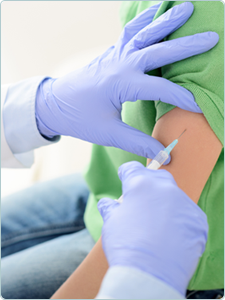Insights
What Health Equity Efforts Can Learn from Immunization Initiatives
While vaccinations help ensure that children will be less likely to be affected by preventable conditions, they have also been a tool in closing health disparities (differences in access to or availability of services) between population. As many professionals and organizations strive to achieve health equity, the drive to improve immunization rates is a replicable success story that can be applied repeatedly.

Between 2009 and 2014, the rate of all U.S. children ages 19 months and 35 months who received their combined seven-vaccine series, which includes common vaccines for poliovirus, measles and tetanus among others, increased from 44.3 percent to 71.6 percent. Similar increases in rates of vaccinations were seen across income levels, ethnicities and between urban, suburban and rural areas. (See Table 1 for an in-depth look at the trends between demographics.) It took decades of multidisciplinary approaches to reach this level, starting with large initiatives at the federal level like the Childhood Immunization Initiative and the Vaccines for Children (VFC) program.
More targeted approaches for specific populations proven beneficial in supporting this national effort and ensuring that equity was achieved between different populations. For example, American Indian/Alaska Native populations throughout the U.S. have a history of health inequities; such as a four-fold increase in flu mortality relative to other populations in 2009. VFC made vaccines more affordable for indigenous people, and population-based efforts such as tribal immunizations programs brought more vaccines to rural and remote populations, leading to improved access and adoption.
Table 1
|
Year |
White |
Black |
American Indian |
Asian |
2 or more races |
Hispanic or Latino |
Below poverty level |
At or above poverty level |
|
2009 |
45.2 |
39.6 |
64.1 (2010) |
38.6 |
40.7 |
45.9 |
41.3 |
45.7 |
|
2014 |
72.6 |
65.4 |
70.1 (2013) |
69.5 |
68.5 |
74.3 |
65.7 |
75.4 |
Source: Health, United States, 2015, U.S. Department of Health and Human Services
“Making changes to improve health at a population level takes a multi-sector and multi-disciplinary approach,” said NICHQ Chief Science Officer, Joann Petrini, PhD, MPH. “It’s a combination of understanding the needs of specific communities and developing strategies at that level, as well as policies that affect the overall population. In NICHQ’s work, we’ve found that focused ground-up approaches have the greatest promise for improving health equity.”
This is the state in which everyone in a population has the opportunity to attain full health potential and no one is disadvantaged from achieving this potential because of social position or any other socially defined circumstance or social determinant of health (e.g., race, ethnicity, income, educational level, housing).
A good example of this is the Plano Independent School District in Texas, which has three elementary schools with non-vaccination rates over 3.5 percent. Some of this is attributed to diminished levels of confidence in vaccines. So, while government intervention and other efforts have supported most the population, there is still opportunity to reach people within this community. Research shows a demographic trend: White families with incomes over $75,000 tend to be more likely to refuse or delay vaccinations. This information has allowed stakeholders in public health, at the government, state and community level, to develop strategies and approaches for this population.
Continuing vaccine efforts show localized approaches can support smaller groups of people and new approaches are necessary to maintain progress for everyone. While complete equity hasn’t been achieved, the strides in closing disparities show that supporting every population is possible and that evolving strategies are necessary to ensure that progress isn’t lost to new challenges. That’s not just how immunization initiatives work, it’s how drives to close disparities in all aspect of health can move forward.
